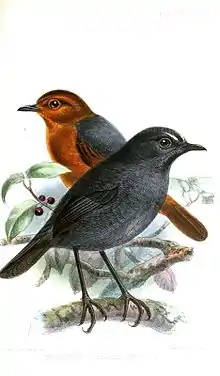Brachypteryx
Brachypteryx is a genus of passerine birds containing six species known as shortwings, that occurs in southeast Asia.
| Brachypteryx | |
|---|---|
 | |
| White-browed shortwing, (Brachypteryx montana) | |
| Scientific classification | |
| Kingdom: | Animalia |
| Phylum: | Chordata |
| Class: | Aves |
| Order: | Passeriformes |
| Family: | Muscicapidae |
| Subfamily: | Saxicolinae |
| Genus: | Brachypteryx Horsfield, 1821 |
Shortwings are small birds with long legs, finely pointed bills, short tails and short rounded wings. They are shy elusive ground-dwellers that generally prefer the cover of dense undergrowth.[1]
The genus Brachypteryx was introduced by the American naturalist Thomas Horsfield in 1821.[2] The word comes from the classical Greek brakhus mean "short" and pterux meaning "wing".[3] The genus was previously placed in the thrush family Turdidae but in 2010 two separate molecular phylogenetic studies found that species in the genus were more closely related to members of the Old World flycatcher family Muscicapidae.[4][5]
The genus contains the following species:[6]
- Rusty-bellied shortwing, Brachypteryx hyperythra
- Lesser shortwing, Brachypteryx leucophris
- White-browed shortwing, Brachypteryx montana
- Himalayan shortwing, Brachypteryx cruralis
- Chinese shortwing, Brachypteryx sinensis
- Taiwan shortwing, Brachypteryx goodfellowi
Whilst the white-browed and rusty-bellied shortwings show strong sexual plumage dimorphism, the lesser shortwing is sexually monomorphic.
Three other species were formerly placed in Brachypteryx:
- Great shortwing, Heinrichia calligyna
- Nilgiri blue robin or Nilgiri shortwing Myiomela major
- Gould's shortwing, Heteroxenicus stellata
References
- Clement, Peter (2016). Robins and Chats. Helm Identification Guides. London: Bloomsbury. p. 182. ISBN 978-1-4081-5596-7.
- Horsfield, Thomas (1821). "Systematic arrangement and description of birds from the island of Java". Transactions of the Linnean Society of London (in Latin and English). 13 (1): 133–200 [157]. The paper was first read in April 1820. The title page is dated 1822.
- Jobling, James A. (2010). The Helm Dictionary of Scientific Bird Names. London: Christopher Helm. p. 76. ISBN 978-1-4081-2501-4.
- Sangster, G.; Alström, P.; Forsmark, E.; Olsson, U. (2010). "Multi-locus phylogenetic analysis of Old World chats and flycatchers reveals extensive paraphyly at family, subfamily and genus level (Aves: Muscicapidae)". Molecular Phylogenetics and Evolution. 57 (1): 380–392. doi:10.1016/j.ympev.2010.07.008. PMID 20656044.
- Zuccon, D.; Ericson, P.G.P. (2010). "A multi-gene phylogeny disentangles the chat-flycatcher complex (Aves: Muscicapidae)". Zoologica Scripta. 39 (3): 213–224. doi:10.1111/j.1463-6409.2010.00423.x.
- Gill, Frank; Donsker, David (eds.). "Chats, Old World flycatchers". World Bird List Version 6.2. International Ornithologists' Union. Retrieved 20 May 2016.